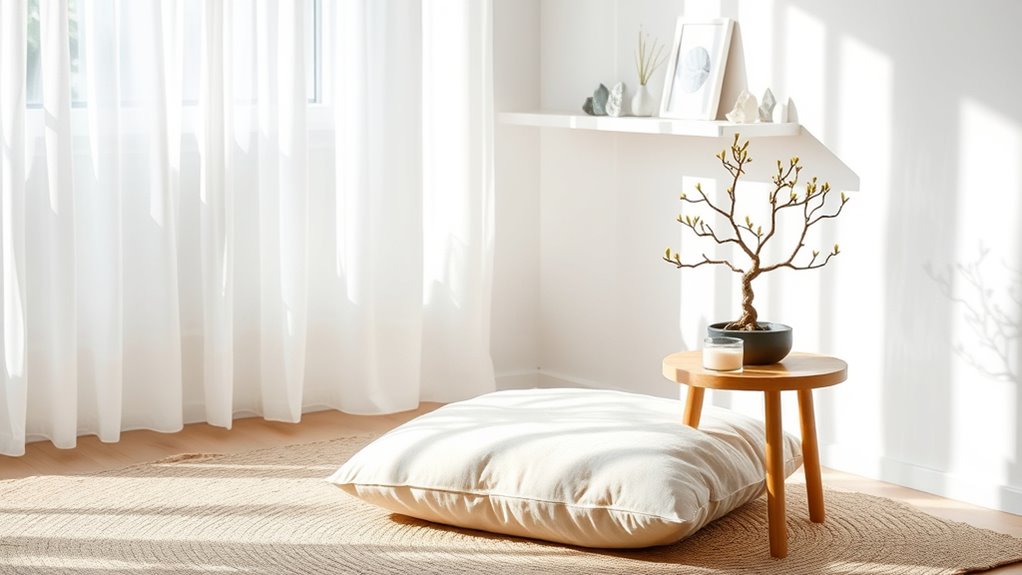To create a soothing mindfulness corner at home, choose a quiet spot away from noise, with calming colors like soft blue or green. Add comfortable seating, natural elements like plants or stones, and soft lighting such as candles or fairy lights. Personalize the space with meaningful decor and calming scents like lavender. Keep the area clutter-free and regularly refresh it to maintain a peaceful atmosphere. If you keep exploring, you’ll discover more tips to customize your retreat.
Key Takeaways
- Choose a quiet, clutter-free outdoor or corner space with calming natural elements and soft lighting.
- Select comfortable seating and personalize with meaningful decor, scents, and inspiring artwork.
- Incorporate natural plants, textures, and grounding colors like greens, blues, or neutrals.
- Add sensory tools such as textured stones, aromatherapy, and soft fabrics to enhance mindfulness.
- Maintain organization, regularly declutter, and adjust lighting and decor to sustain a tranquil environment.
Selecting the Perfect Location
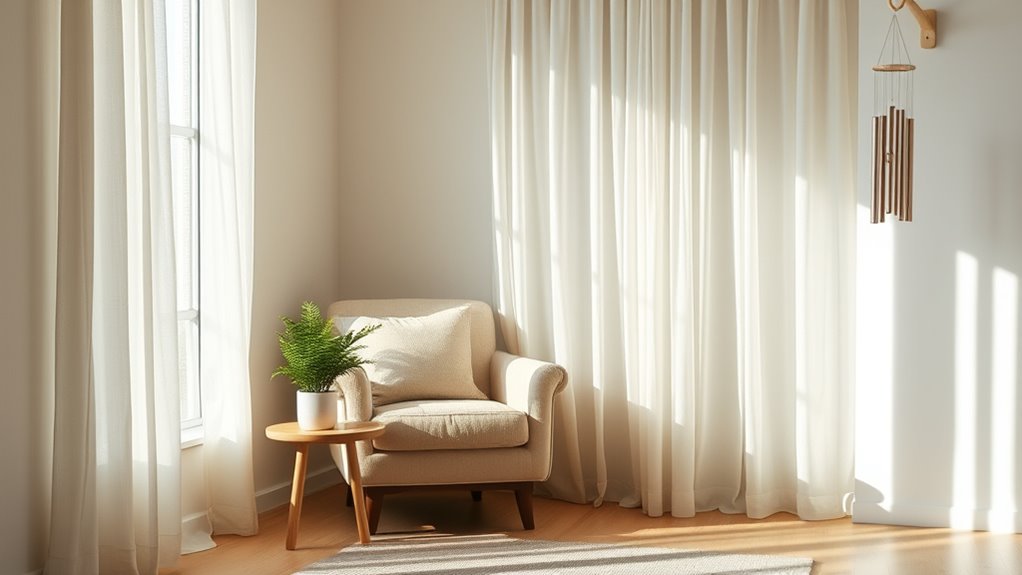
Choosing the right spot for your mindfulness corner is essential to creating a peaceful and inviting space. An outdoor garden offers a natural, calming environment that enhances your mindfulness practice. Look for a quiet corner away from noise and distractions, where you can connect with nature. A minimalist design works best, so select a spot that won’t become cluttered easily. Keep the area simple, with plenty of open space to breathe and reflect. Consider placing your mindfulness corner near plants, water features, or shaded areas to boost relaxation. Incorporating wall organization systems can help maintain a clean and serene environment. The goal is to create a serene haven where you feel comfortable and focused. With the right outdoor setting and minimalist approach, your mindfulness corner will become a restorative retreat.
Choosing Calming Colors and Decor

Once you’ve selected a peaceful outdoor spot, the next step is to create a soothing atmosphere through colors and decor. Use color psychology to choose calming shades like soft blues, gentle greens, or warm neutrals that promote relaxation. Incorporate decor accessories that enhance tranquility, such as candles, nature-inspired artwork, or textured fabrics. Here are four ideas to elevate your space:
- Opt for pastel or muted tones to foster serenity.
- Add natural elements like stones or plants for grounding energy.
- Use soft lighting with fairy lights or lanterns for a gentle glow.
- Incorporate simple decor accessories that evoke mindfulness, like zen sand gardens or inspirational quotes. Enhancing the environment with natural elements can further support your mindfulness practice by creating a more balanced and harmonious space.
These choices help create a harmonious environment perfect for mindfulness practices.
Incorporating Comfortable Seating
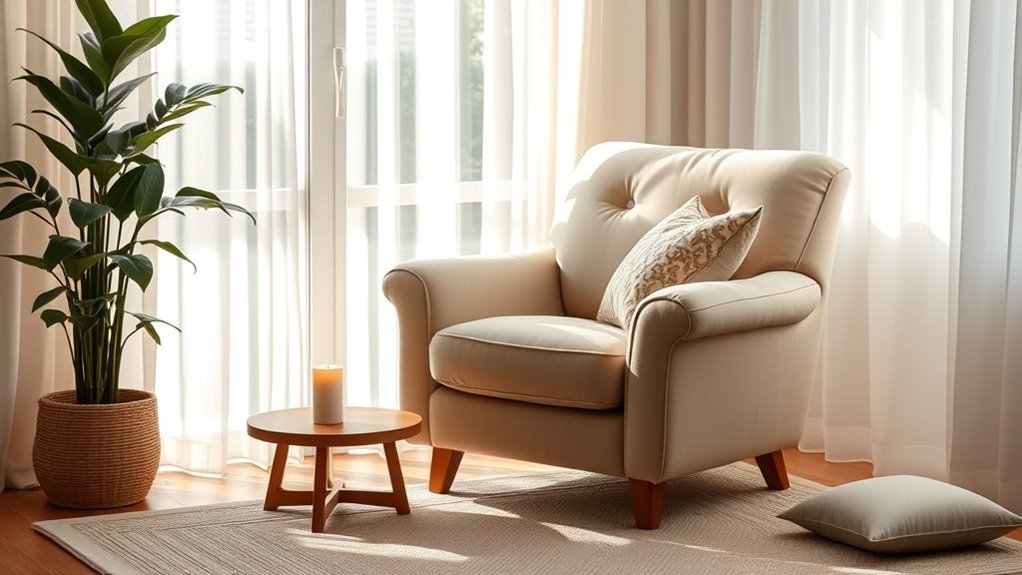
Choosing cozy chairs is essential to create a welcoming space for mindfulness. Add cushions and throws to make your seating even more comfortable and inviting. With the right setup, you’ll find it easier to relax and stay present during your practice. Incorporating elements like appetizers can also help set a calming atmosphere.
Choosing Cozy Chairs
A comfortable chair can transform your mindfulness corner into a welcoming, calming space. When choosing cozy chairs, prioritize ergonomic support to guarantee comfort during meditation or reflection. Material durability matters too, so pick chairs made from sturdy fabrics or woods that withstand regular use. Consider these factors:
- Ergonomic support for proper posture
- Material durability for long-lasting comfort
- Size and space fit for your designated area
- Ease of movement and stability
A well-chosen chair encourages you to sit comfortably for longer periods, helping deepen your mindfulness practice. Additionally, selecting a chair with appropriate design features can enhance overall comfort and support. Avoid sacrificing comfort for style; instead, find a balance that promotes relaxation and support. A cozy, supportive chair is key to making your mindfulness corner inviting and effective.
Using Cushions and Throws
Adding cushions and throws to your seating transforms your mindfulness corner into an even more inviting retreat. Proper cushion placement enhances comfort and encourages relaxation, so arrange them to support your back and hips. Mix different sizes and textures for visual interest and a cozy feel. When choosing throws, consider color schemes that promote calm—soft neutrals, gentle pastels, or muted earth tones work well. Draping a throw over your chair or floor cushion invites you to settle in and feel at ease. Be intentional with your choices, balancing comfort and aesthetics. Incorporating personalized care into your space can further support emotional well-being and promote a sense of security. This simple addition makes your space more inviting, helping you stay present during meditation or quiet reflection. Comfort is key to creating a mindfulness corner you’ll want to return to daily.
Adding Natural Elements and Plants

Incorporating natural elements and plants into your mindfulness corner can instantly create a calming atmosphere. An indoor garden or herbal arrangements bring life and freshness to your space, making it more inviting and peaceful. To enhance your setup, consider these ideas:
- Add small potted plants like succulents or ferns for easy maintenance.
- Use floating shelves to display colorful herbal arrangements.
- Incorporate natural textures such as driftwood or stones.
- Place a few hanging plants to create a layered, lush environment.
- Choose natural materials for decor accents to further emphasize your connection with nature.
These elements not only boost the aesthetic but also promote relaxation and mindfulness. Natural greenery helps clear your mind, reduces stress, and enhances your connection with nature, making your mindfulness corner a true sanctuary.
Including Mindfulness Tools and Accessories
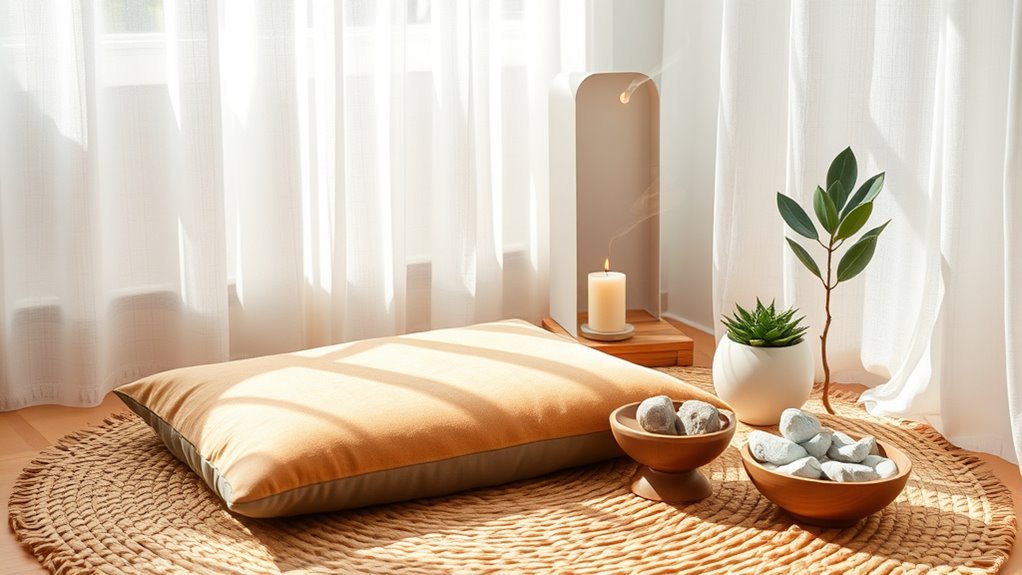
Adding mindfulness tools and accessories can enhance your space and deepen your practice. Consider including calming visual elements, sensory engagement items, and practical meditation tools to create a welcoming atmosphere. These additions help you stay focused and cultivate a sense of tranquility during your mindfulness moments. Incorporating well-being practices such as guided meditations or breathing exercises can further support your mindfulness journey.
Calming Visual Elements
Creating a calming visual space at home involves carefully selecting mindful tools and accessories that promote relaxation. To achieve visual harmony and enhance aesthetic appeal, choose items that create a serene environment. Consider adding:
- Soft, neutral-colored cushions or throws for comfort
- Minimalist artwork or calming nature images for tranquility
- Gentle, warm lighting such as fairy lights or lanterns
- Natural elements like small plants or stones for grounding
- Incorporate visual balance by arranging items thoughtfully to avoid clutter and maintain a peaceful atmosphere.
These visual elements should complement each other, fostering a peaceful ambiance. When your space maintains a balanced aesthetic, it naturally encourages mindfulness and reduces stress. Focus on simplicity and consistency to ensure your mindfulness corner remains inviting and visually soothing. This thoughtful approach helps you create a visually harmonious area perfect for daily relaxation.
Sensory Engagement Items
To deepen your mindfulness practice, include sensory engagement items that invite you to focus on the present moment. These tools help you tune into tactile sensations, grounding you in the here and now. Incorporate items like textured stones, soft fabrics, or stress balls to engage your senses actively. Use the following table to explore some options:
| Sensory Engagement Items | Benefits |
|---|---|
| Textured stones | Enhance tactile sensations |
| Soft fabrics | Promote calming tactile feedback |
| Stress balls | Relieve tension and sharpen focus |
| Fidget toys | Increase concentration |
| Aromatherapy bottles | Combine scent with tactile engagement |
Adding these items creates a rich, sensory environment that encourages present-moment awareness and mindfulness. Incorporating mindfulness techniques into your environment can further amplify these benefits.
Practical Meditation Tools
Practical meditation tools and accessories can substantially enhance your mindfulness practice by making it more accessible and comfortable. These tools support your journey into mindfulness meditation and breathing exercises, helping you stay focused and relaxed. Consider adding:
- Meditation cushions or mats for comfortable seating
- A timer or bell to signal the start and end of your session
- Aromatherapy diffusers or calming scents to create a soothing environment
- Guided meditation apps or recordings to deepen your practice
- AI safety measures are increasingly important to ensure that AI technologies used in health and wellness applications remain trustworthy and secure.
These items can make your mindfulness corner more inviting and functional, encouraging regular practice. With the right tools, you’ll find it easier to cultivate calm and clarity through mindfulness meditation and breathing exercises, enriching your overall well-being.
Creating a Soft Lighting Atmosphere
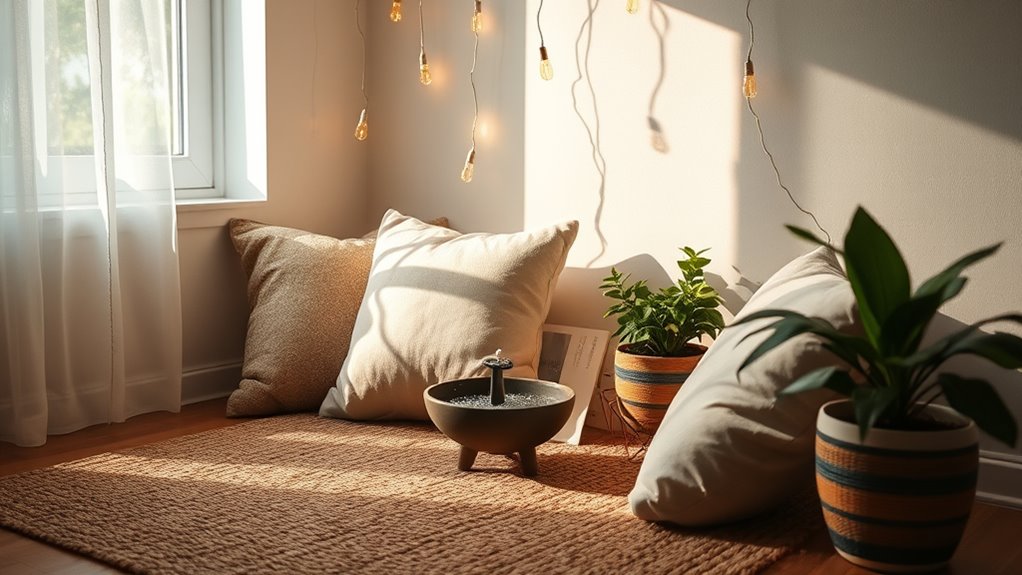
A soft lighting atmosphere instantly sets a calming tone in your mindfulness corner, making it easier to relax and focus. Using soft lighting creates a gentle glow that minimizes harsh shadows and distractions, helping you feel more at ease. Incorporate ambient illumination, such as warm-toned lamps, fairy lights, or candles, to establish a cozy environment. Dimmer switches allow you to adjust the light levels, tailoring the space to your mood. Avoid bright, direct lighting that can disrupt your sense of calm. Instead, opt for layered lighting sources that provide a subtle, soothing glow. This gentle illumination encourages mindfulness by reducing visual clutter and promoting a peaceful atmosphere, perfect for meditation, reflection, or simply unwinding.
Establishing a Clutter-Free Environment

Soft lighting helps create a calm atmosphere, but even the most soothing environment can be disrupted by clutter. To support your mindfulness practices, you need a clutter-free space that promotes focus and relaxation. Here are four key steps:
- Dedicate a specific area for your mindfulness corner.
- Regularly declutter by removing unnecessary items.
- Use storage solutions to keep essentials organized.
- Practice clutter management daily to prevent buildup.
Personalizing Your Space With Meaningful Items
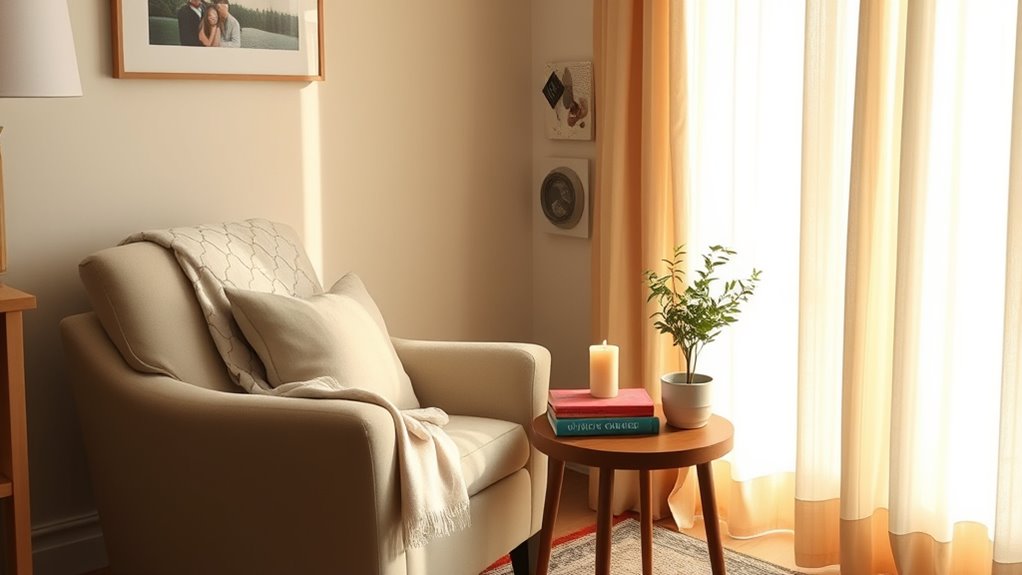
Adding meaningful items to your mindfulness corner helps personalize the space and deepen your connection to your practice. Incorporate personalized artwork that resonates with you, such as calming images or inspiring quotes, to create a sense of comfort and familiarity. Display meaningful keepsakes like a special stone, a handwritten note, or a small memento that holds sentimental value. These items serve as visual anchors, reminding you of your intentions and progress. When your space reflects what matters most to you, it becomes a sanctuary for reflection and relaxation. Take time to select items that evoke positive emotions and inspire mindfulness. By curating your space with these personal touches, you transform it into a truly meaningful retreat at home.
Incorporating Aromatherapy and Scents
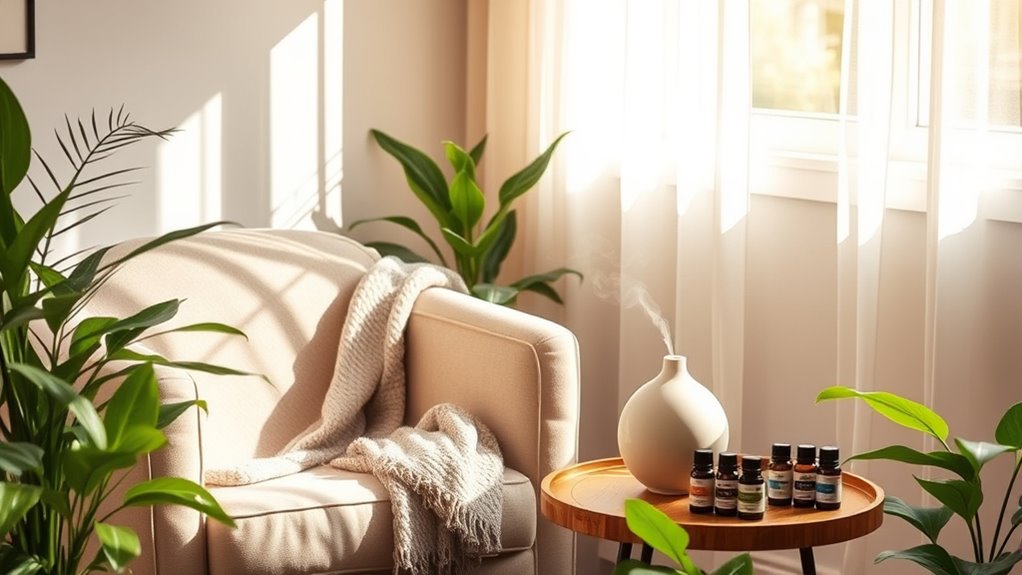
Adding calming scents can enhance your mindfulness space and promote relaxation. Using essential oil diffusers or scented candles can create a soothing atmosphere when chosen carefully. Just remember to prioritize safety and select scents that truly help you feel centered.
Choosing Calming Scents
Choosing calming scents for your mindfulness corner can substantially enhance your relaxation experience. When selecting scents, focus on aromatic blends known for promoting tranquility, such as lavender, chamomile, or sandalwood. You can also practice scent layering by combining complementary aromas to deepen your calming environment. Here are some ideas to get started:
- Use lavender and vanilla for a soothing, sweet aroma
- Combine eucalyptus and peppermint for invigorating clarity
- Mix chamomile with sandalwood for a gentle, grounding effect
- Experiment with citrus and rosemary for an uplifting yet calming scent
Essential Oil Diffusers
Have you considered how an essential oil diffuser can elevate your mindfulness space? A diffuser adds a gentle, calming aroma that enhances relaxation and focus during your practice. To keep it functioning at its best, regular diffuser maintenance is vital—clean it according to the manufacturer’s instructions to prevent residue buildup. When selecting essential oil blends, opt for calming scents like lavender, chamomile, or cedarwood to create a soothing environment. Using an diffuser allows you to customize your scent experience, making your mindfulness corner uniquely yours. Just a few drops of your favorite essential oils can transform your space into a tranquil retreat. Proper diffuser maintenance ensures consistent performance, so you can enjoy a continuous, calming atmosphere during your mindful moments.
Scented Candle Safety
While scented candles can enhance your mindfulness space with calming aromas, it’s vital to prioritize safety to prevent accidents. Proper scented candle safety involves paying close attention to flame precautions. Here are four essential tips:
- Never leave a lit candle unattended, especially around children or pets.
- Keep candles away from flammable objects like curtains or paper.
- Use a sturdy, heat-resistant holder to prevent tipping.
- Extinguish the flame fully before leaving the room or going to sleep.
Maintaining and Refreshing Your Sanctuary
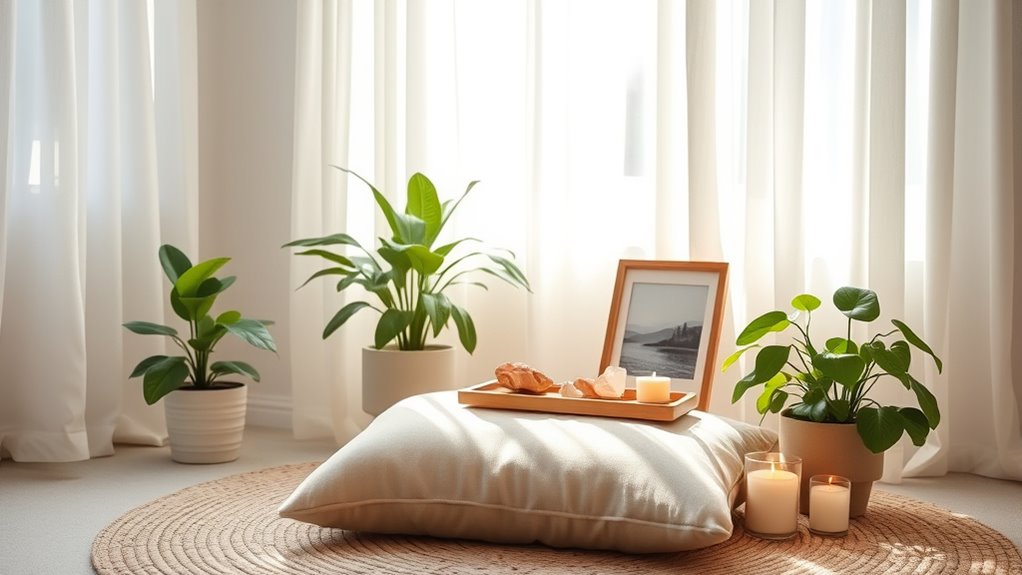
Regularly maintaining and invigorating your mindfulness sanctuary keeps it a welcoming space that supports your practice. Over time, clutter or dust can diminish its calming effect, so give it a quick tidy-up. Refresh your space by rotating new plants, artwork, or meaningful objects to keep the environment inspiring. Incorporate fresh elements like new candles or soothing textures to renew its serenity. Remember, your sanctuary should be a dedicated spot for mindfulness meditation and stress reduction techniques, so guarantee it remains comfortable and clutter-free. Periodic updates help prevent your space from feeling stagnant, encouraging regular use. With a little effort, your mindfulness corner stays inviting and effective, helping you stay centered and relaxed whenever you need a peaceful retreat at home.
Frequently Asked Questions
How Often Should I Update My Mindfulness Corner?
You might wonder how often to update your space personalization and decor maintenance. It’s best to refresh your mindfulness corner every few months to keep it inspiring and aligned with your needs. Regular updates allow you to incorporate new meaningful items or change the layout, keeping the space fresh and engaging. This way, your mindfulness corner remains a supportive sanctuary that evolves with your journey and enhances your daily practice.
Can I Share My Mindfulness Space With Others?
You can definitely share your mindfulness space with others, but consider privacy concerns first. Sharing space allows loved ones to benefit from the calm environment, but make sure everyone respects boundaries. Communicate your needs clearly and set boundaries if needed. If privacy becomes an issue, create designated times or areas to maintain your mindfulness practice. Balancing sharing and respecting privacy ensures a peaceful, supportive environment for everyone involved.
What Are Some Budget-Friendly Ways to Create a Mindfulness Corner?
You can create a mindfulness corner using budget materials and DIY decor. Look for inexpensive items like candles, cushions, or plants from thrift stores or dollar stores. Use printable quotes or artwork to personalize the space without spending much. Repurpose items you already have, like old jars or fabric, to add a calming touch. Focus on simplicity and comfort, making your space inviting without breaking the bank.
How Do I Keep My Mindfulness Space Allergy-Free?
To keep your mindfulness space allergy-free, you should use an air purifier to remove dust and allergens from the air. Incorporate hypoallergenic decor like washable cushions, silk plants, and natural fiber rugs to reduce dust buildup. Regularly clean and vacuum the area, and opt for hypoallergenic curtains. These steps help create a calm, healthy environment, making it easier to focus and practice mindfulness without allergy concerns.
Are There Specific Mindfulness Practices Suited for This Space?
You can enhance your mindfulness practice by using guided meditations tailored for relaxation and focus. Incorporate calming visuals like nature scenes or gentle colors to deepen your sense of peace. These practices help you stay present and centered, making your space more effective. By regularly engaging with guided meditations and soothing visuals, you create a tranquil environment that supports your mental well-being and helps you unwind daily.
Conclusion
Creating your mindfulness corner transforms a simple space into a peaceful sanctuary. Picture yourself sinking into a cozy chair, surrounded by gentle scents and soft colors that soothe your mind. As you breathe in the calming atmosphere, you feel a wave of tranquility wash over you. Keep this space fresh and inviting, a personal oasis where you can pause, breathe, and reconnect—making mindfulness a natural, comforting part of your daily life.
